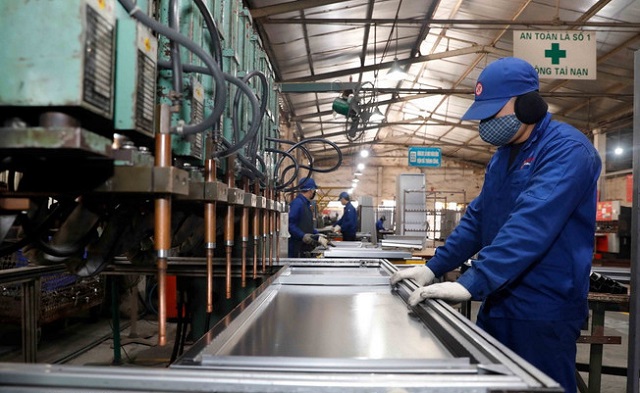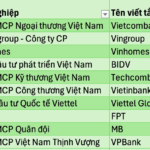
|
Factory workers at an FDI company. (Photo: Tuan Anh/VNA)
|
The merger of provinces and cities will not only facilitate the development of infrastructure and utilities but also boost investment in the coming years.
Significant administrative reforms are expected to unlock resources and remove bottlenecks for the private sector, thus boosting investor confidence.
As of today, July 1, 2025, the local government apparatus at the two levels in 34 provinces and cities will officially operate.
On June 30, a ceremony was held nationwide to announce the National Assembly’s resolution on the merger of provinces and cities, along with the Central Party’s decisions on the establishment of Party committees and local leadership.
According to General Secretary To Lam, the decision to “rearrange the territory” is a historic step with strategic significance, marking a new stage in the development of a modern state administrative apparatus, a complete political system that is streamlined, effective, and efficient, towards a modern, governance-oriented administration, close to the people, and serving the people, so that all benefits belong to the people.
General Secretary To Lam also emphasized that reorganizing the administrative boundaries and operating a new local government model is an objective and inevitable requirement for the country’s development in the context of globalization, digital transformation, and the Fourth Industrial Revolution.
The rearrangement of administrative units will not only bring a new face to the local government but also open up a vast and promising development space for each region, locality, and the whole country.
Analysts compare this reform to “Renewal 2.0” after the economic renewal in 1986. This event is expected not only to create new growth momentum for Vietnam but also to support the maintenance of stable credit prospects in the context of prolonged global instability.
Experts from VCBS (Vietcombank Securities Company) evaluate that the merger of provinces and cities will result in larger scales in terms of area, population, and economy, facilitating infrastructure and utility development.
For example, after merging with Binh Duong and Ba Ria-Vung Tau, Ho Chi Minh City will become a “super metropolis” in the ASEAN region and the largest economic scale in Vietnam, with an area of over 6,700 km², a population of nearly 14 million people, and a GRDP of over 2.7 million billion VND.
The new provinces and cities not only expand the scale but also integrate different types of terrain and development advantages. Ho Chi Minh City (new) will thus have a comprehensive economic strength, including urban economics (old Ho Chi Minh City), industry and FDI (Binh Duong), and port services, logistics, and tourism (Ba Ria-Vung Tau).
In addition, the combination of regional characteristics such as sea, plain, and mountains also helps provinces strengthen comprehensive socio-economic links. Ha Nam, when merged with Nam Dinh and Ninh Binh, will form a large economic pole in the North, with industry, tourism, and urban pillars.
The merger of Da Nang and Quang Nam will also expand the development space for Da Nang’s urban and industrial-service areas, thereby exploiting the special mechanism and the establishment of a Free Trade Area.
With abundant land, population, and resources, local governments can now comfortably plan economic development areas and transportation systems over a large area, reducing the risk of non-connectivity in other localities as before. This is especially significant for large industrial projects, which often require a synchronized logistics system conveniently connected to sources of raw materials, labor, and large-scale port and airport infrastructure.
Besides, the merger of provinces and cities can significantly improve capital allocation efficiency and budget management by concentrating resources. This can overcome the previous situation where some localities were limited in terms of population scale, economy, and budget resources and, thus, faced difficulties in realizing their development vision due to their dependence on central government subsidies.

|
Activities at the stamping workshop of Xuan Hoa Joint Stock Company, Phuc Yen city, Vinh Phuc province. (Photo: Tran Viet/VNA)
|
Mr. Michael Kokalari, Director of Macroeconomic Analysis and Market Research at VinaCapital, said that the ongoing restructuring of the government apparatus is part of a series of strong actions to help Vietnam escape the “middle-income trap.”
According to Mr. Michael Kokalari, these efforts focus on enhancing the value of urban areas, improving regional planning for infrastructure development, and reducing the bureaucracy of the administrative apparatus. The key to the success of this reform lies in integrating digital transformation in public services and promoting synchronous implementation.
Experts from VIS (Vietnam Credit Rating Joint Stock Company) evaluate that a streamlined administration and supportive government policies will boost infrastructure projects and sustain more robust economic growth.
According to Mr. Nguyen Dinh Duy, Director and Senior Analyst at VIS Rating, the administrative merger at the provincial level will streamline decision-making processes and improve budget allocation efficiency. At the central level, the requirement to reduce 30% of administrative procedures will also help expedite policy implementation and remove legal barriers for many economic sectors.
“The important administrative reforms being implemented, such as streamlining the government apparatus, merging provincial-level units, and simplifying administrative procedures, are helping to unlock resources and remove bottlenecks for the private sector,” said Mr. Duy.
Recently, the Politburo also issued four breakthrough resolutions signaling a strategic shift in the long term – boosting the private sector, prioritizing the development of green and high-tech industries, and strengthening legal institutions.
VIS believes that, with the government’s plan to increase infrastructure spending in the second half of the year, the domestic business environment will receive positive support, and the innovation process will proceed smoothly, thereby boosting investor confidence. At the same time, Vietnam’s credit conditions are expected to remain stable in the second half of 2025, thanks to proactive fiscal policies and positive institutional reforms, mitigating the impact of global instability.
Hua Chung
– 13:56 07/01/2025
The Most Expensive Road in Da Nang: Unveiling the City’s Priciest Real Estate Hotspot
The heart of Da Nang city boasts an impressive portfolio of prime real estate. With coastal roads and beachfront properties demanding prices in the hundreds of millions of dong per square meter, this thriving city is a hub of opportunity and a testament to Vietnam’s thriving economy.
“Proposed Establishment of a State-Run Real Estate Trading Center”
The Ministry of Construction has been working in close collaboration with the Vietnam Real Estate Brokerage Association to research and develop supportive practice mechanisms. Notably, they have proposed the establishment of a state-managed Real Estate Trading Center, which stands out as a significant initiative.
What Province Does the Spratly Special Zone Belong To?
The newly reorganized special administrative unit, the Spratly Islands, is now part of Khanh Hoa province.











![[Photo Essay]: Experts, Managers, and Businesses Unite to Forge a Path Towards Sustainable Green Industry](https://xe.today/wp-content/uploads/2025/07/z678592918-150x150.jpg)


![[Photo Essay]: Experts, Managers, and Businesses Unite to Forge a Path Towards Sustainable Green Industry](https://xe.today/wp-content/uploads/2025/07/z678592918-100x70.jpg)






